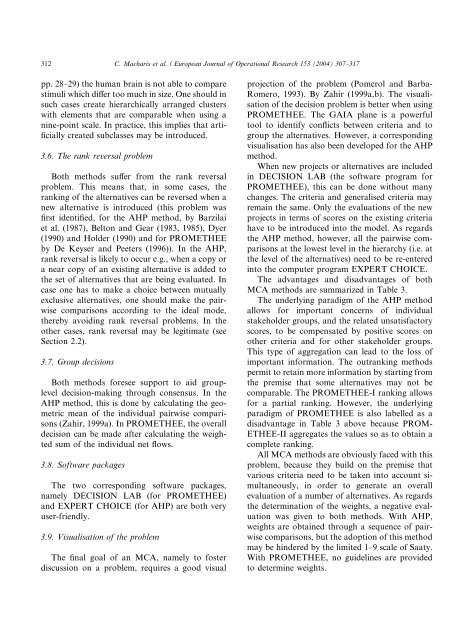PROMETHEE and AHP: The design of operational synergies in ...
PROMETHEE and AHP: The design of operational synergies in ...
PROMETHEE and AHP: The design of operational synergies in ...
Create successful ePaper yourself
Turn your PDF publications into a flip-book with our unique Google optimized e-Paper software.
312 C. Macharis et al. / European Journal <strong>of</strong> Operational Research 153 (2004) 307–317<br />
pp. 28–29) the human bra<strong>in</strong> is not able to compare<br />
stimuli which differ too much <strong>in</strong> size. One should <strong>in</strong><br />
such cases create hierarchically arranged clusters<br />
with elements that are comparable when us<strong>in</strong>g a<br />
n<strong>in</strong>e-po<strong>in</strong>t scale. In practice,this implies that artificially<br />
created subclasses may be <strong>in</strong>troduced.<br />
3.6. <strong>The</strong> rank reversal problem<br />
Both methods suffer from the rank reversal<br />
problem. This means that,<strong>in</strong> some cases,the<br />
rank<strong>in</strong>g <strong>of</strong> the alternatives can be reversed when a<br />
new alternative is <strong>in</strong>troduced (this problem was<br />
first identified,for the <strong>AHP</strong> method,by Barzilai<br />
et al. (1987),Belton <strong>and</strong> Gear (1983,1985),Dyer<br />
(1990) <strong>and</strong> Holder (1990) <strong>and</strong> for <strong>PROMETHEE</strong><br />
by De Keyser <strong>and</strong> Peeters (1996)). In the <strong>AHP</strong>,<br />
rank reversal is likely to occur e.g.,when a copy or<br />
a near copy <strong>of</strong> an exist<strong>in</strong>g alternative is added to<br />
the set <strong>of</strong> alternatives that are be<strong>in</strong>g evaluated. In<br />
case one has to make a choice between mutually<br />
exclusive alternatives,one should make the pairwise<br />
comparisons accord<strong>in</strong>g to the ideal mode,<br />
thereby avoid<strong>in</strong>g rank reversal problems. In the<br />
other cases,rank reversal may be legitimate (see<br />
Section 2.2).<br />
3.7. Group decisions<br />
Both methods foresee support to aid grouplevel<br />
decision-mak<strong>in</strong>g through consensus. In the<br />
<strong>AHP</strong> method,this is done by calculat<strong>in</strong>g the geometric<br />
mean <strong>of</strong> the <strong>in</strong>dividual pairwise comparisons<br />
(Zahir,1999a). In <strong>PROMETHEE</strong>,the overall<br />
decision can be made after calculat<strong>in</strong>g the weighted<br />
sum <strong>of</strong> the <strong>in</strong>dividual net flows.<br />
3.8. S<strong>of</strong>tware packages<br />
<strong>The</strong> two correspond<strong>in</strong>g s<strong>of</strong>tware packages,<br />
namely DECISION LAB (for <strong>PROMETHEE</strong>)<br />
<strong>and</strong> EXPERT CHOICE (for <strong>AHP</strong>) are both very<br />
user-friendly.<br />
3.9. Visualisation <strong>of</strong> the problem<br />
<strong>The</strong> f<strong>in</strong>al goal <strong>of</strong> an MCA,namely to foster<br />
discussion on a problem,requires a good visual<br />
projection <strong>of</strong> the problem (Pomerol <strong>and</strong> Barba-<br />
Romero,1993). By Zahir (1999a,b). <strong>The</strong> visualisation<br />
<strong>of</strong> the decision problem is better when us<strong>in</strong>g<br />
<strong>PROMETHEE</strong>. <strong>The</strong> GAIA plane is a powerful<br />
tool to identify conflicts between criteria <strong>and</strong> to<br />
group the alternatives. However,a correspond<strong>in</strong>g<br />
visualisation has also been developed for the <strong>AHP</strong><br />
method.<br />
When new projects or alternatives are <strong>in</strong>cluded<br />
<strong>in</strong> DECISION LAB (the s<strong>of</strong>tware program for<br />
<strong>PROMETHEE</strong>),this can be done without many<br />
changes. <strong>The</strong> criteria <strong>and</strong> generalised criteria may<br />
rema<strong>in</strong> the same. Only the evaluations <strong>of</strong> the new<br />
projects <strong>in</strong> terms <strong>of</strong> scores on the exist<strong>in</strong>g criteria<br />
have to be <strong>in</strong>troduced <strong>in</strong>to the model. As regards<br />
the <strong>AHP</strong> method,however,all the pairwise comparisons<br />
at the lowest level <strong>in</strong> the hierarchy (i.e. at<br />
the level <strong>of</strong> the alternatives) need to be re-entered<br />
<strong>in</strong>to the computer program EXPERT CHOICE.<br />
<strong>The</strong> advantages <strong>and</strong> disadvantages <strong>of</strong> both<br />
MCA methods are summarized <strong>in</strong> Table 3.<br />
<strong>The</strong> underly<strong>in</strong>g paradigm <strong>of</strong> the <strong>AHP</strong> method<br />
allows for important concerns <strong>of</strong> <strong>in</strong>dividual<br />
stakeholder groups,<strong>and</strong> the related unsatisfactory<br />
scores,to be compensated by positive scores on<br />
other criteria <strong>and</strong> for other stakeholder groups.<br />
This type <strong>of</strong> aggregation can lead to the loss <strong>of</strong><br />
important <strong>in</strong>formation. <strong>The</strong> outrank<strong>in</strong>g methods<br />
permit to reta<strong>in</strong> more <strong>in</strong>formation by start<strong>in</strong>g from<br />
the premise that some alternatives may not be<br />
comparable. <strong>The</strong> <strong>PROMETHEE</strong>-I rank<strong>in</strong>g allows<br />
for a partial rank<strong>in</strong>g. However,the underly<strong>in</strong>g<br />
paradigm <strong>of</strong> <strong>PROMETHEE</strong> is also labelled as a<br />
disadvantage <strong>in</strong> Table 3 above because PROM-<br />
ETHEE-II aggregates the values so as to obta<strong>in</strong> a<br />
complete rank<strong>in</strong>g.<br />
All MCA methods are obviously faced with this<br />
problem,because they build on the premise that<br />
various criteria need to be taken <strong>in</strong>to account simultaneously,<strong>in</strong><br />
order to generate an overall<br />
evaluation <strong>of</strong> a number <strong>of</strong> alternatives. As regards<br />
the determ<strong>in</strong>ation <strong>of</strong> the weights,a negative evaluation<br />
was given to both methods. With <strong>AHP</strong>,<br />
weights are obta<strong>in</strong>ed through a sequence <strong>of</strong> pairwise<br />
comparisons,but the adoption <strong>of</strong> this method<br />
may be h<strong>in</strong>dered by the limited 1–9 scale <strong>of</strong> Saaty.<br />
With <strong>PROMETHEE</strong>,no guidel<strong>in</strong>es are provided<br />
to determ<strong>in</strong>e weights.









